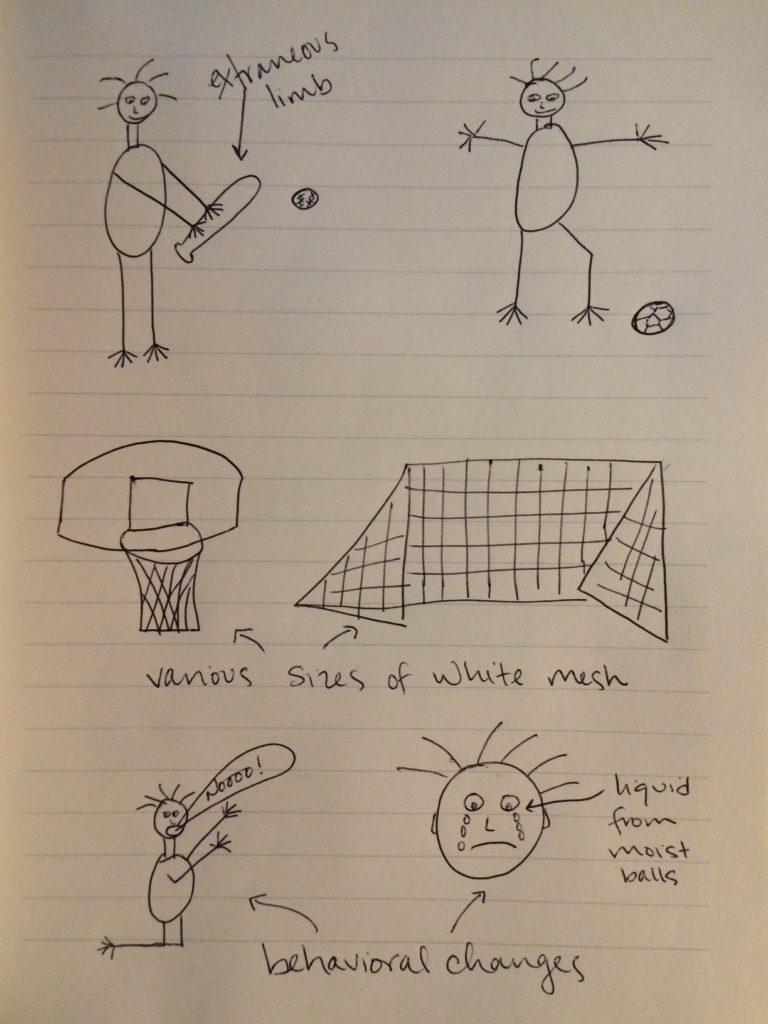Entry: Physical Activity
Many of this species engage in activity that incites perspiration and acute air intake and exhalation through the cavities on the front of the top round mound, as well as extreme behavioral changes. This activity is carried out in three main ways.
Individually:
A portion of this species prefers to engage in activity alone. To do this some pump their elongated limbs back and forth, increasing the rate at which they pump to increase or decrease the speed at which they move forward, backwards, or side-to-side. This occurs both on the ground and in large bodies of liquid. Some will either move themselves from one location to another, while some engage in this repetitive action on a mechanical machine that propels a wide belt below their bottom limbs – allowing them to remain stationary even while increasing the rate at which their bottom limbs pump forward and backward. In addition to the mechanical machine with a wide belt, there are also machines that allow for similar stationary movement while the species’ main mound of flesh and four elongated limbs are in different positions.

Other forms of solo activity include the lifting and dropping of heavy metal objects. For this activity, individuals will grab varying sizes of solid pieces of metal and move their elongated limbs in different motions. In addition, some will also push or pull metal plates attached to a pulley/lever system with only their top elongated limbs, or with only their bottom elongated limbs. Often this species will emit short, low-decibel sounds from the large cavity at the front of the top round mound as they lift, drop, push, or pull these varying sizes of metal pieces.

In groups:
Many of this species seem to prefer to engage in physical activity in groups. These groups will gather in an enclosed area and carry out synchronized motions directed by an appointed leader. These synchronized motions usually involve some form of extending or pumping the elongated limbs, or pushing up and down off the floor with the bottom smaller limbs while swinging out the upper elongated limbs. In addition, this synchronizing of motions is often accompanied by high-pitched, rhythmic decibel sounds emitted by an extraneous machine and often by the appointed leader as well.

In opposing groups:
The third form of physical activity observed occurs in opposing groups with some type of a spherical object. Once split into two groups, this species engages with the spherical object in different ways. Some grab at it with their upper elongated limbs and propel it away from them and toward another. Others swing their lower elongated limbs toward the spherical object and make contact to propel it toward another. Others still propel the object away with an extraneous limb, like so:

After propelling or receiving a spherical object, these species then often propel the spherical object toward areas of various-sized white mesh placed at both opposite ends of an enclosed space. If the spherical object touches the white mesh this elicits multiple reactions from the species. Some pump their elongated limbs in the air and emit high-pitched sounds from their large cavity, some touch their smaller upper limbs to other’s smaller upper limbs, some contract the characteristics on their small round mound and emit low decibel sounds from their large cavity, some expand the characteristics on their small round mound, some fall to the ground by bending their lower elongated limbs in the middle, while some emit liquid from their two round moist balls. It is unclear at this time why propelling a spherical object towards areas of white mesh is responsible for eliciting such extreme behavioral changes, but it is obvious that the white mesh is important to this species. One hypothesis is that the white mesh is some sort of deity.
Note: In accordance with code OBEWH2016 the final report will be submitted on January 1, 2018 to the higher council of extra-planetary research. Objective observations are sent every 7 full rotations of the planet in respect to its star and followed by a short summary of findings as directed in the standardized outline for observational reports presented in Handbook 32.7767.96.7970.
